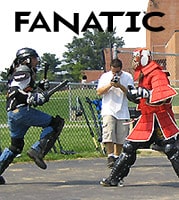With empty hands, with weapons—especially when armed in both hands—the most universally principal of guarding is asymmetry.
One leg should always be forward, one refused.
One hand should always be forward, one refused.
The narrowing of your target area is only one concern. In a relatively square open guard, the need for asymmetry is accentuated by the need for the boxer or wrestler to assign different tasks to each hand. In boxing, for instance, when open, one hand needs to guard the body and the other the head, as trying to guard the body and the head with each hand on its own side as done in a standard oblique guard leaved your groin, wind, throat and nose wide open.
The most obvious case for an absolute need for asymmetry is kicking. One cannot use each leg identically at the same time while kicking.
The area were trained fighters tend to fall into symmetrical guards are in FMA, fighting with two knives or two sticks. Non-contact training sets ignore the hand as a target, promoting the use of a symmetrical low hand guard in siniwali [don’t care that I misspelled it] stroke patterns in order to more effectively go through the bilateral feeder drills. These drills were conceived as coordination exercises to promote Filipino style weaponry among American empty hand martial artists. Fighting with the exact weapon in each hand has a very slim legacy in 17th century England [double swords], Canton [double butterfly knives or swords] and of the 17 types of gladiators in ancient Rome only two the Scissor and the Dimarchareus fought with an identical weapon in each hand.
I like sparring with the double baton or double stick as a drill for enhancing stick and boxing adaptability at the same time and increasing the conditioning of the stick fighter. During the course of this I have discovered that the more highly trained, classically instructed martial artist are way behind unschooled fighters in combat applications simply because they have each hand at an identical gate and also stand square, relying too much on the weaponry and not enough on domination of the combat space.
If my sparring partner is holding both his sticks in the best single stick guard [that is hand above hip and stick tip at the opposite eye] then his hands are easy meat and he is easily turned. Any time I hit one hand I know without looking that I can hit the other and do so.
Since, outside of a rare sporting context, combat between two individuals armed symmetrically in both hands has never and will likely never happen, the most corrosive effect of symmetrical double weapon drills is to unseat the fighter’s oblique guard, get him to focus too much on the weapons in hand, rather than the behavior of the antagonist and condition him to drift to an open guard when exhausted.
Being a Bad Man in a Worse World
Fighting Smart: Boxing, Agonistics & Survival
Twerps, Goons and Meatshields: The Basics of Full Contact Stick-Fighting
link › jameslafond.blogspot.com










